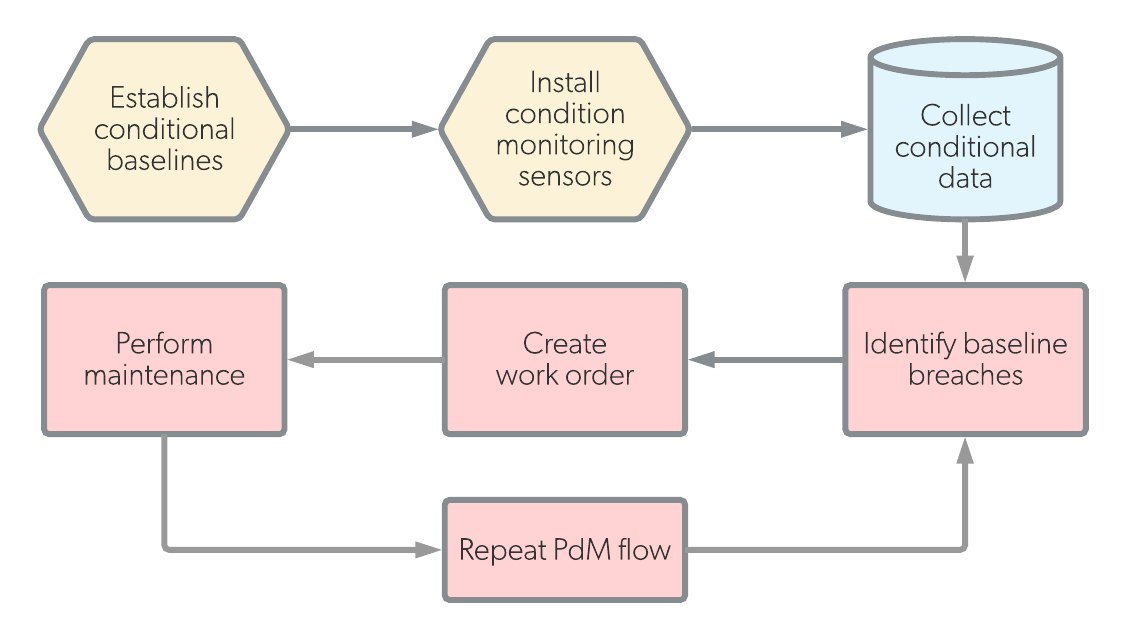What Is Predictive Maintenance in Manufacturing?
How effective is your equipment maintenance program? Do you base it on old asset manuals, seasonal schedules, run times, or anecdotal knowledge?
If so, you're missing essential data on your equipment usage, environment, and processes. Without this information, your maintenance program can waste resources, unnecessarily damage expensive assets, cause costly downtime, and even put your team at risk.
So, how can you create a complete, data-driven maintenance program?
The answer: a predictive maintenance (PdM) plan.
In this guide, you'll discover all you need to know about a PdM plan—including how to create one—so you can reduce errors and downtime in your manufacturing facility.
What Is Predictive Maintenance (PdM)?
Predictive maintenance, or PdM, is a data-driven maintenance practice for monitoring and analyzing an asset's performance, status, and overall health in real-time. It's a type of condition-based maintenance in that it collects measurements on a piece of equipment's condition (i.e., pressure, temperature, or vibration) through sensor devices.
A manufacturing facility that engages in PdM will know when its assets require maintenance, preventing critical issues like equipment failure. Equipment failures can cause delays, significant repairs, product defects, and unhappy customers—all of which come with high costs.
All manufacturing facilities want to avoid these issues, and some may attempt to address them through a preventive maintenance program where managers schedule maintenance after a specific duration of time or usage. This practice involves estimating the time when a piece of equipment may wear out or need repair based on past performance and problems.
While preventive maintenance can be a helpful approach, PdM is the most effective and advanced maintenance program available since it eliminates guesswork and unnecessary maintenance while simultaneously spotting new or unexpected issues before they cause failures and downtime.

How Does Predictive Maintenance Work?
In a PdM practice, data is at the center of all activities. To ensure your PdM program is effective, you'll first establish conditional baselines for your assets, serving as your control values. You'll use these baselines for comparison once you install sensors and start collecting real-time data on your equipment's performance.
Continuously collecting and evaluating real-time sensor data will ensure you receive alerts whenever your equipment deviates from the established control value, triggering your predictive maintenance protocol through your software. This system empowers your team to resolve issues as quickly as they occur.
There are numerous forms of sensor data that you may rely on depending on your industry and equipment. Here are three of the most critical data sources for establishing a PdM practice:
Vibration Analysis
Vibration analysis is a critical element of predictive maintenance for manufacturing facilities with high-speed machinery. It’s a well-established form of condition monitoring and is an affordable way to detect issues like looseness, imbalance, misalignment, and bearing wear.
Infrared Analysis
Infrared analysis measures temperature. It’s a simple and low-cost way to prevent costly problems. Facilities can use this data on many types of equipment, and it's able to identify issues related to cooling, airflow, and even motor stress.
Sonic Acoustical Analysis
Sonic acoustical analysis is similar to vibration analysis, but it has a greater focus on sound versus motion. It monitors vibrations at specific frequencies, recording data for monitoring and analysis. Sonic acoustical analysis helps spot lubrication issues that technicians can then proactively address.
Benefits of Predictive Maintenance for Manufacturing
Did some of the examples above remind you of past experiences in your manufacturing facility? If so, the advantages of predictive maintenance may already be clear to you, but if not, here's a look at the most impactful benefits of PdM.
Decrease Downtime
One of the most significant advantages of a predictive maintenance program is a decrease in downtime. Downtime is expensive with it costing industrial manufacturers up to $50 billion annually.
Implementing a PdM program reduces this expensive problem in two primary ways:
- Performing shutdown-required maintenance only as-needed, and
- Reducing unexpected failures as a result of pattern prediction and early fault detection.
Downtime can be a frustrating and costly issue, but with a PdM program, you don't have to worry about losing hours of time and profits.
Increase Employee Productivity
Your employees will be more productive under a PdM model due to the ability to target their repair efforts. With more information available, they can make repairs quickly, use a smaller number of components, conduct less troubleshooting, and stop relying on guesswork. A PdM program will also reduce the overall frequency of repairs.
Additionally, a strong PdM practice offers emotional and employee morale advantages that can increase productivity. Through predictive maintenance, you can reduce stressful emergent repairs and confusing problem-solving, and you can avoid accidents before they happen, preventing worker injuries.
Optimize Equipment Lifetime
Predictive maintenance will help your assets stay operational longer without you needing to replace or refurbish them. Condition monitoring and quick repairs can stop minor issues before they cause extensive damage. Additionally, a PdM program can alert you to tasks like keeping shafts balanced, bearings lubricated, windings clean, fasteners tight, and your electrical wiring in good repair—all of which will help your manufacturing equipment last as long as possible.
Reduce Maintenance Costs
With decreased downtime, increased productivity, and long-lasting equipment, your maintenance team will enjoy much lower expenses. The benefits of predictive maintenance don’t stop there, though. Your manufacturing facility will also see cost savings in the forms of:
- Increased efficiency: Your facility will see reduced power use due to efficient equipment operating, and you'll align the consumption of maintenance supplies such as lubricants and filters more with actual needs, not a potentially wasteful schedule.
- Fewer overall repairs: Targeted maintenance and longer-lasting equipment will result in fewer overall repairs, reducing labor and supply expenses.
How To Implement Predictive Maintenance
Now that you understand the benefits of PdM, it’s time to start setting up a unique and effective predictive maintenance plan for your facility.
It’s also a critical process to address as your company grows or if your manufacturing processes change. This advanced, effective form of maintenance can be easily broken down into the following four actionable steps.
1. Plan Your Program
When planning your program, start with the end: What types of failure do you want to prevent? What data sources will offer relevant information on the issues behind those failures? What types of sensors can capture that information?
Once you know what you want to track (and how you can track it), you'll then need to establish the data baselines you'll measure your data collection against.
2. Install Internet of Things (IoT) Devices
The internet of things, or IoT, is the use of the internet to connect technology embedded in non-computer tools, machines, and other objects, allowing them to send and receive data.
For predictive maintenance in a manufacturing setting, using IoT involves installing relevant sensors on your equipment. Examples could include vibration and sonic acoustic meters on a mechanical asset with gears that require lubrication.
3. Plan System Integrations
Now that you have your plan created and sensors installed, it’s time to organize all of the data that those first two steps will produce. The information will be much more manageable and actionable when you integrate it into a computerized maintenance management system (CMMS) or remote dashboard where you can easily collect and analyze the data.
Curious about CMMS? See the Top 10 Benefits of a CMMS System.
4. Schedule Maintenance
In this final step, you'll schedule any necessary maintenance.
One of the many benefits of system integrations is they can enable your CMMS to schedule inspections and repairs automatically when an asset surpasses its baseline limit. You can also manually schedule maintenance by team members who are monitoring your data dashboards.
Start Operating More Effectively with UpKeep’s Predictive Maintenance Solution
A haphazard, ill-informed maintenance program can hurt your bottom line, customer relationships, team member morale, and even workplace safety.
A contemporary, well-developed PdM program that capitalizes on technology makes it easy to prevent these problems by capturing valuable data and making it accessible to act on effectively. The many benefits make it clear to see the returns on the investment needed to put predictive maintenance to work at your manufacturing facility.
When you're ready to optimize your asset maintenance and reliability, consider a cloud-based Asset Operations Management and PdM solution like UpKeep. Our platform equips every maintenance, reliability, and operations team with the tools and information you need to run an efficient PdM program.
With UpKeep’s CMMS and PdM capabilities, you can improve your manufacturing maintenance management process, lower costs, ensure team safety, and gain data-backed insights to guide current and future projects.
Try Upkeep for free today: Get a Free Product Tour
Want to keep reading?
Predictive Maintenance
Preventive vs. Predictive Maintenance: What’s the difference?
What are the best metrics and KPIs for manufacturing companies?
4,000+ COMPANIES RELY ON ASSET OPERATIONS MANAGEMENT
Leading the Way to a Better Future for Maintenance and Reliability
Your asset and equipment data doesn't belong in a silo. UpKeep makes it simple to see where everything stands, all in one place. That means less guesswork and more time to focus on what matters.

![[Review Badge] Gartner Peer Insights (Dark)](https://www.datocms-assets.com/38028/1673900494-gartner-logo-dark.png?auto=compress&fm=webp&w=336)
